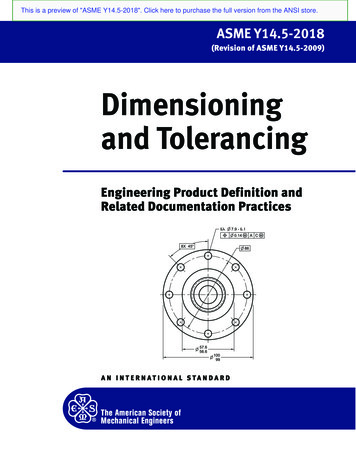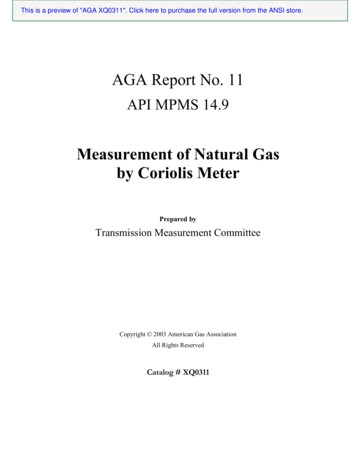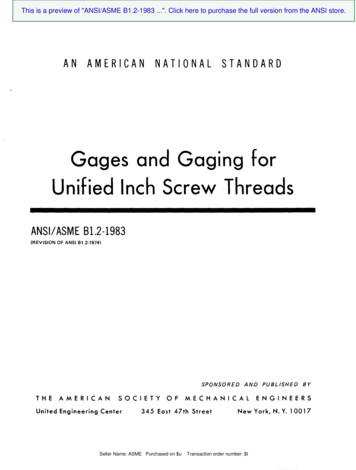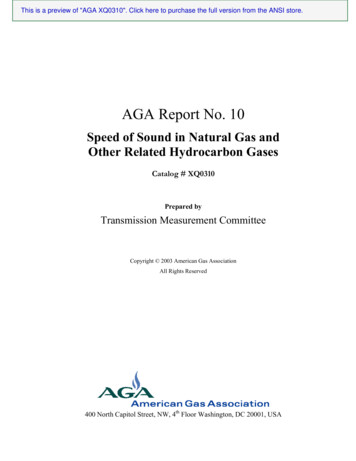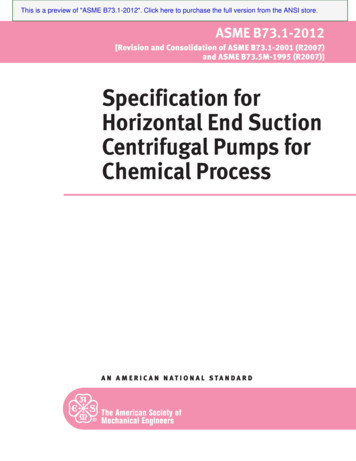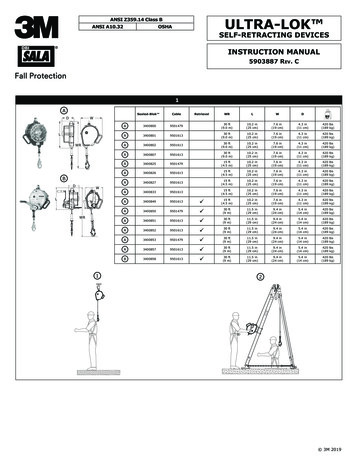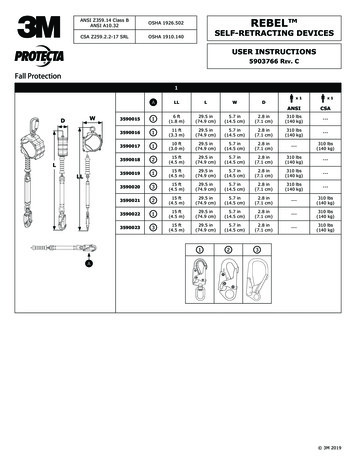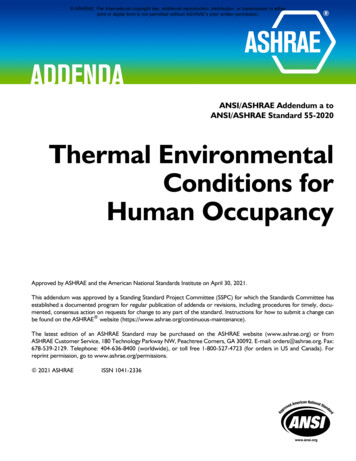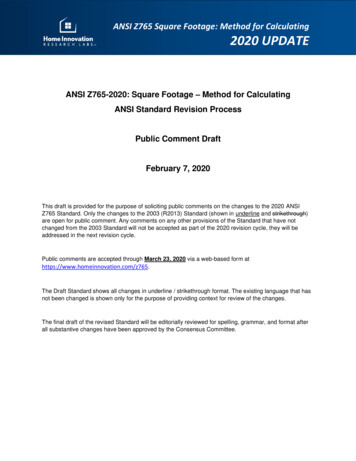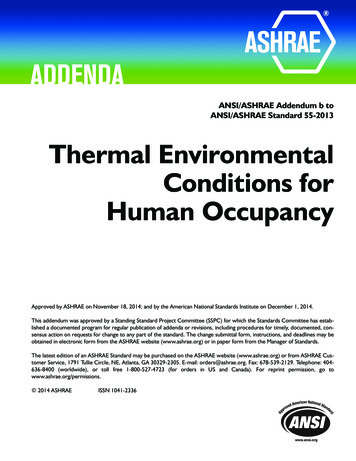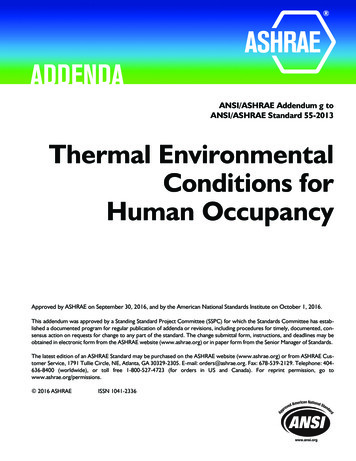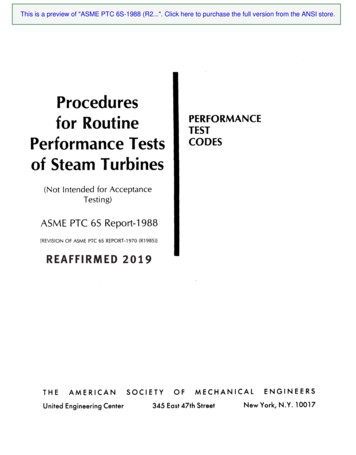
Transcription
This is a preview of "ASME PTC 6S-1988 (R2.". Click here to purchase the full version from the ANSI store.Proceduresfor RoutinePerformance Testsof Steam TurbinesPERFORMANCETESTCODES(Not Intended for AcceptanceTesting)ASME PTC 6s Report-1988[REVISION OF ASME PTC 65 REPORT-1970 (R1985)ITHEAMERICANSOCIETYUnited Engineering CenterOFMECHANICAL345 East 47th StreetENGINEERSNewYork, N.Y.10017
This is a preview of "ASME PTC 6S-1988 (R2.". Click here to purchase the full version from the ANSI store.Date of issuance: December 15, 1989This document will be revised when the Society approves the issuance of thenext edition, scheduledfor 1992. Therewill be nlo Addenda issuedto PTC 6sReport-1988.Please Note: ASME issues written replies to inquiries concerning interpretationof technicai aspects of this document. PTC 6s Report-1988 is being issuedwith an automatic subscription service to the interpretations that will be issuedtu it up to the publication of the 1992 Edition.ASME is the registered trademark of The American Society of Mechanical Engineers.This code or standard was developed under procedures accredited as meeting the criteria forAmerican National Standards. The ConsensusCommittee that approved the code or standardwas balanced to assure that individuals from competent and concerned interests have had anopportunity to participate. The proposed codeo r standard was made available for public reviewand comment which provides an opportunity for additional pu:blicinput fromindustry, academia,regulatory agencies, and the public-at-large.ASME does not "approve," "rate," or "endorse" any item, c:onstruction,proprietary device, oractivity.ASME does not take any position with respect to the validity ofany patent rights asserted inconnection with any items mentioned in this document, and does not undertake to insure anyoneutilizing a standard against liability for infringement of any applicable Letters Patent, nor assumeany such liability. Users of a code or standard are expressly advised that determination of thevalidity of any such patent rights, and the risk of infringement of such rights, is entirely their ownresponsibility.Participation by federal agency representative(s) or person(s) affiliated with industry is not tobe interpreted as government or industry endorsement of this code or standard.ASME accepts responsibility for only those interpretations issued in accordance with governingASME procedures and policies which preclude the issuance of interpretations by individual volunteers.No part of this document may be reproduced in any form,in an electronic retrieval system or otherwise,without the prior writtenpermission of thepublisher.Copyright 0 1989 byTHE AMERICAN SOCIETYOF MECHANICAL ENGINEERSAll Rights ReservedPrinted in the U.S.A.
This is a preview of "ASME PTC 6S-1988 (R2.". Click here to purchase the full version from the ANSI store.FOREWORD(This Foreword is not part of ASME PTC 6 s Report-1988.)Users of bothlarge and small turbines haveexperienced an increasing need for proceduresfor routine turbinetests which trend performance with time. The use of full-scale ASME Performance Test Code procedures and instrumentation for this purpose i s expensive and produces information and accuracy beyond that necessary for periodic monitoring. WhenASME Performance Test Code Committee No. 6 was reorganized to revise PTC 6-1 949, itwas charged also with developing simplifiedprocedures for periodic tests. Because of theroutine nature of the tests, these procedures were to emphasize repeatability of results ratherthan absolute accuracy and thus provide a more economic means of monitoring performance trends.This Report reflects the consensus of knowledgeable engineers and contains recommended procedures for collecting sufficiently accurate data to permit analyses of performance trends. Recommendations are given which include advance planning, cycle isolation, and suggested presentation of results. Emphasis is placed upon the use of accurate instrumentation, approaching measurement uncertainties required by the Code, for themeasurement of criticalvariables that are part of the heat-rate equation. Other instrumentation i s specified to produce results of good accuracy and of a high degree of repeatability.With the application ofautomatic data-loggingand on-line computer systems to the plantcycle, the procedures presented in this Report, when applied tothis end, should satisfy theneeds of users of bothlarge and small turbines.Procedures recommended in this Report are not intended to produce abolute levels ofperformance. If absolute performance level is required, the ASME Test Code for Steam Turbines, PTC 6, 1976, reaffirmed 1985, or the Interim Test Code for an Alternative Procedurefor Testing Steam Turbines, PTC 6.1, 1984, should be followed. For other levels of accuracy,where the test instrumentation varies from the Test Code specified procedure, the Report byPTC Committee No. 6 on ”Guidance for Evaluation of Measurement Uncertainty in Performance Tests of Steam Turbines,” 1985 should be consulted.Users of this Report are requested to comment and provide tothe Committee supportingdata obtained with these procedures. Such comment and repeatability data covering longterm and/or extensive experience will provideguidance for subsequent revisions of this Report. User suggestions and data should be submitted to the Secretary, ASME PerformanceTest Codes Committee, 345 East 47th Street, New York, New York 10017.This Report was approved by the ASME Board on Performance Test Codesand adopted asa standard practice of the Society on May8, 1988. It was approved as an American NationalStandard by the ANSI Board of Standards Review on September 8, 1988.iii
This is a preview of "ASME PTC 6S-1988 (R2.". Click here to purchase the full version from the ANSI store.All ASME codes are copyrighted, with all rights reservedto the Society.Reproduction ofshould a pthis or any other ASME code is a violation of Federal Law. Legalities aside, the userpreciate that thepublishing of the high quality codes that havetypified ASME documents rework diligently toquires a substantial commitment by the Society. Thousands of volunteersdevelop these codes. Theyparticipate on their own or with a sponsor's assistance and produce documents that meet the requirementsof an ASME concensus standard. The codes arevery valuable pieces ofliterature to industry and commerce, and theeffort to improve these"living documents" and develop additional needed codes must becontinued. The moniesspent for research and further code development,administrative staff support andpublication are essential andconstitute a substantial drain on ASME. The purchase price of thesedocuments helps offsetthese costs. User reproduction undermines thissystem and represents anadded financial drain on ASME. When extra copiesare needed,you are requestedtocall or write the ASME Order Department, 2 2 Law Drive, Box 2300, Fairfield, New Jersey07007-2300, and ASME will expedite delivery of such copies to you by returnmail. Pleaseinstruct your people to buy required test codes rather thancopy them. Yourcooperation inthis matter is greatly appreciated.iv
This is a preview of "ASME PTC 6S-1988 (R2.". Click here to purchase the full version from the ANSI store.PERSONNEL OF PERFORMANCE TEST CODE COMMITTEE NO. 6ON STEAM TURBINES(The following is the roster of the Committee at the time of approval of this Code.)OFFICERSE.W. A. Campbell, ChairmanJ.Brailey, Jr., Vice ChairmanJ.H. Karian, SecretaryCOMMITTEE PERSONNEL1. M. Baltrus, Sargent & Lundy EngineersJ.A. Booth, General Electric Co.P. C . Albert, Alternate fo Booth, General Electric Co.B. Bornstein, ConsultantE.J.Brailey, Jr., New England Power Service Co.1. M. Brown, Ontario HydroW. A. Campbell, Philadelphia Electric Co.K. C. Cotton, ConsultantJ. S. Davis, Jr., Duke Power Co.R. D. Smith, Alternate to Davis, Duke Power Co.N. R. Deming, Consulting EngineerP. A. DiNenno, lr., ConsultantA. V. Fajardo, Jr., Utility PowerCorp.C. Cartner, Alternate to Fajardo, Utility Power Corp.J.H. Karian, The American Society of MechanicalEngineersD. L. Knighton, Black & Veatch Engineers-ArchitectsC. H. Kostors, Elliott Co.J.5. Larnberson, Dresser RandT. H. McCloskey, Electric Power Research InstituteS. S. Sandhu, Westinghouse Electric Corp.C. B. Scharp, Consulting EngineerP. Scherba, Public Service Electric & Gas Corp.I. A. McAdarns, Alternate toScherba, Pubic Service Electric 81 Gas Corp.E. 1. Sundstrorn, Dow Chemical USA(In addition tothe above personnel, the Committee is indebted to Ms. E. Pitchford of Lower Colorado Riverthis Standard.)Authority andH.S. Arnold of Public Service Electric & Cas Corp. for their efforts on the early work ofV
This is a preview of "ASME PTC 6S-1988 (R2.". Click here to purchase the full version from the ANSI store.BOARD ON PERFORMANCE TEST CODESj. 5. Davis, Jr., ChairmanDeming, Vice ChairmanW. 0. Hays, Secretar'yN. R.A. F. ArmorR. L. BannisterR. j. Biesej. A. BoothB. BornsteinW. A. CrandallH. G. Crim, jr.1. 5. Davis, Jr.N. R. DemingG. J. GerberW. 0. HaysR. jorgensenD. R. Keyserj. E. Kirkland, Jr.W. G. McLeanG. H. Mittendorf, Jrj. W. MurdockviS. P. NusplR. P. PerkinsR. W. PerryA. L. PlumleyC. B. ScharpJ. W. SiegmundR. E. SommerladI . C. Westcott
This is a preview of "ASME PTC 6S-1988 (R2.". Click here to purchase the full version from the ANSI store.CONTENTSForeword . . . . . . . . . . . . . . . . . . . . . . . . . . . . . . . . . . . . . . . . . . . . . . . . . . . . . . . . .Committee Roster . . . . . . . . . . . . . . . . . . . . . . . . . . . . . . . . . . . . . . . . . . . . . . . . . .Section012345678910111213Figures2.14.1 (a)4.1 (b)4.1 (c)4.24.34. 4(a)4.4(b)4.55.15.25.3introduction . . . . . . . . . . . . . . . . . . . . . . . . . . . . . . . . . . . . . . . . . . . . . .Object. Scope. and Intent . . . . . . . . . . . . . . . . . . . . . . . . . . . . . . . . . . . .Definitions and Description ot Terms . . . . . . . . . . . . . . . . . . . . . . . . . . .Guiding Principles . . . . . . . . . . . . . . . . . . . . . . . . . . . . . . . . . . . . . . . . .Instruments and Methods of Measurement . . . . . . . . . . . . . . . . . . . . . . .Preliminary Test . . . . . . . . . . . . . . . . . . . . . . . . . . . . . . . . . . . . . . . . . . .Presentation and Interpretation of Test Results . . . . . . . . . . . . . . . . . . . .Test for Nonextraction Condensing Turbine With SuperheatedInlet Steam . . . . . . . . . . . . . . . . . . . . . . . . . . . . . . . . . . . . . . . . . . . . .Test for Condensing Turbine. Regenerative Cycle. WithSuperheated Inlet Steam . . . . . . . . . . . . . . . . . . . . . . . . . . . . . . . . . . .Test for Condensing Turbine. Reheat Regenerative Cycle.With Superheated Inlet Steam . . . . . . . . . . . . . . . . . . . . . . . . . . . . . . .Test Tor Condensing Turbine. Regenerative Cycle. WithSaturated Inlet Steam . . . . . . . . . . . . . . . . . . . . . . . . . . . . . . . . . . . . . .Test tor Noncondensing Nonextraction Turbine. w i t hSuperheated Exhaust . . . . . . . . . . . . . . . . . . . . . . . . . . . . . . . . . . . . . .Test tor Noncondensing Extraction Turbine . . . . . . . . . . . . . . . . . . . . . .Special Procedures for Indicating Turbine-Cycle PerformanceTrends . . . . . . . . . . . . . . . . . . . . . . . . . . . . . . . . . . . . . . . . . . . . . . . . .Temperature-Entropy Diagrams . . . . . . . . . . . . . . . . . . . . . . . . . . . . . . . .Welded Primary Flow Measurement Section . . . . . . . . . . . . . . . . . . . . . .Inspection Port for Feedwater Flow Nozzle . . . . . . . . . . . . . . . . . . . . . .Flanged Primary Flow Measurement Section .Alternate Locations for Primary Flow Element .Connection Between Calibrated Flow Sections andManometers . . . . . . . . . . . . . . . . . . . . . . . . . . . . . . . . . . . . . . . . . . . . .BasketTip . . . . . . . . . . . . . . . . . . . . . . . . . . . . . . . . . . . . . . . . . . . . . . . .Guideplate . . . . . . . . . . . . . . . . . . . . . . . . . . . . . . . . . . . . . . . . . . . . . . .Moisture-Sampling Tube . . . . . . . . . . . . . . . . . . . . . . . . . . . . . . . . . . . . .Typical Turbine Valve-Position Test Data Based on IndividualSteam Pressure Measurements . . . . . . . . . . . . . . . . . . . . . . . . . . . . . . .Typical Turbine Valve-Position Test Data Based on IndividualValve-Lift Measurements . . . . . . . . . . . . . . . . . . . . . . . . . . . . . . . . . . .Stage Group Efficiency by Enthalpy-Drop Method . . . . . . . . . . . . . . . . 29323334
This is a preview of "ASME PTC 6S-1988 (R2.". Click here to purchase the full version from the ANSI store.6.16.2,6.36.46.56.66.76.86.96.106.1 16.126.1 36.146.1 13.1Tables4.18.19.19.29.39.410.111.111.2Typical Blading Diagram for Single Stage . . . . . . . . . . . . . . . . . . . . . . . .Typical Expansion Lines for a High-pressure Section PartialArc Admission. Condensing Turbine . . . . . . . . . . . . . . . . . . . . . . . . . .Typical Expansion Linesfor a High-pressure Section Full-ArcAdmission. Condensing Turbine . . . . . . . . . . . . . . . . . . . . . . . . . . . . .Condensing Turbine Last-Stage Steam Flow Versus StagePressure Ratio . . . . . . . . . . . . . . . . . . . . . . . . . . . . . . . . . . . . . . . . . . .Pressure-Flow Relationship . . . . . . . . . . . . . . . . . . . . . . . . . . . . . . . . . . .Steam Flow Versus First-Stage Nozzle Area . . . . . . . . . . . . . . . . . . . . . . .Stage Pressure Versus StageExit Pressurefor IntermediateStages . . . . . . . . . . . . . . . . . . . . . . . . . . . . . . . . . . . . . . . . . . . . . . . . .Pressure or Capability Curve Versus Chronological Test Dates . . . . . . . . .Corrected Pressure Deviation Interpretations at ConstantControl Valve Opening . . . . . . .
The use of full-scale ASME Per- formance Test Code procedures and instrumentation for this purpose is expensive and pro- duces information and accuracy beyond that necessary for periodic monitoring. When ASME Performance Test Code Committee No. 6 was reorganized to revise PTC 6-1 949, it
